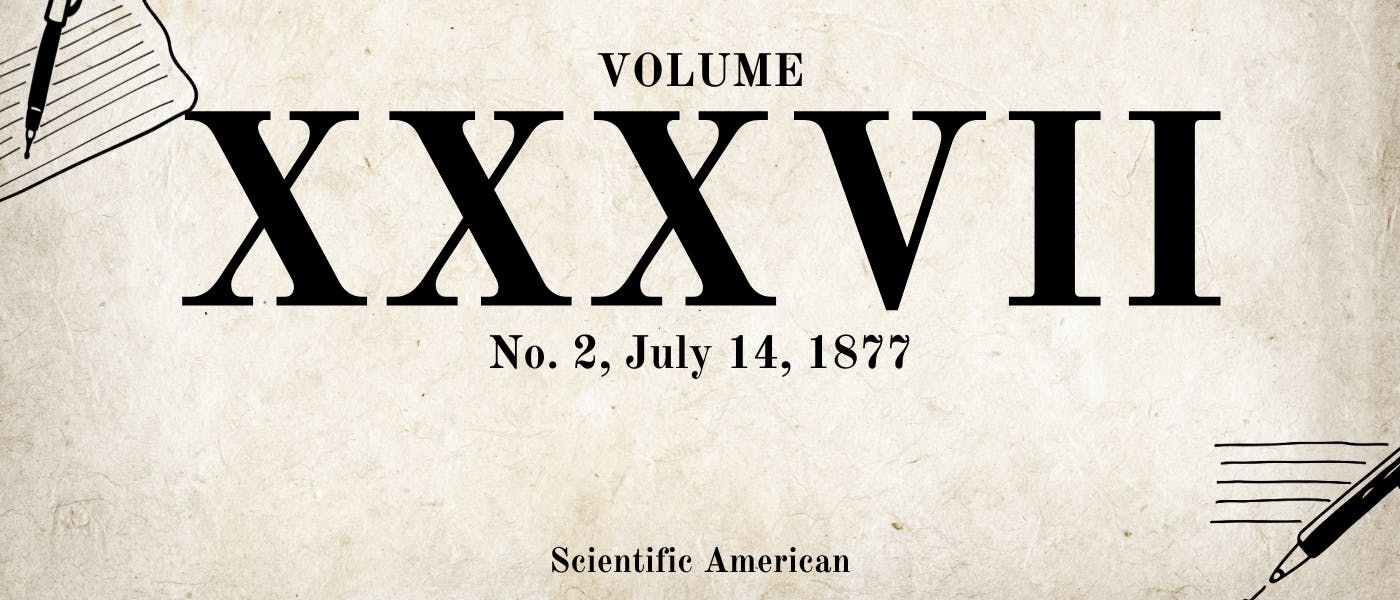Scientific American, Vol. XXXVII.—No. 2. [New Series.], July 14, 1877 by Various, is part of the HackerNoon Books Series. You can jump to any chapter in this book here. DUPLEX EDUCATION.
DUPLEX EDUCATION.
The age in which we live is a fast one, and he who does not move with equal celerity, and keep pace with those around him, is ruthlessly thrust to the wall, and remains there unless he has strength and will to regain the lost position. We call to our aid every force of Nature and invoke the assistance of every appliance with which we are cognizant. We call our fathers slow, and to us they were so; but there was the same need of celerity in their every-day life as to-day there is in ours.
While calling to our aid the elements of Nature and adapting thousands of mechanical appliances to our wants, do we not often feel that there is beyond all these a "something" that may be invoked and trained to help us on in the race of life? Occasionally we find dim glimmerings of this "something" that we believe will eventually grow to be one of the prominent sciences. Physiologists tell us that the human brain is double, that the right and left lobes act in a degree independent of each other—the right lobe of the brain controlling the physiology of the left side of the individual from head to heel, while the left lobe exercises a like dominion on the opposite side. Grant this to be true, then can be explained the idiosyncrasy that is occasionally seen in individuals, of which we may instance that of writing at the same time with both hands; and again we have heard of telegraph operators sending and receiving two messages at the same time, operating with both hands, and independent of each other. It is said that Nasmyth, the inventor of the steam hammer, could actually produce two sketches or drawings in this way and at the same time. It is also affirmed that Sir Charles Fox, the architect of the Exhibition building of 1851, could write upon two ideas at the same time and transfer these ideas simultaneously to paper with right and left hand. The mechanic can often be found who can operate upon one piece of mechanism, while at the same time his brain is busy upon the study of some unborn idea, foreign to that work upon which he is laboring. Writers can be found who can write out one train of ideas, while ideas entirely different are being cogitated upon somewhere in their craniums. We have even heard it affirmed that an indistinct glimmering of a third idea would occasionally peep around the corner of the caputs of these favored ones.
Why not educate this? Why not form schools and institutions to bring it out and lead the brain to perform this double function? It can certainly be done. The world wants it, surely. The age demands it. Individuals need it. If these individuals can succeed and become experts in this method of double work, will not double compensation and a greater remuneration be their reward? This, certainly, will be an incentive to its acquirement. Go to the apprentice when first he takes position beside the vise, with chipping chisel in one hand and hammer in the other. The injunction he mentally receives as he raises the hammer is, that to miss the chisel is to hit his knuckles. After a few demonstrative blows he knows what it means, and therefore chisel and hammer soon come by some strange process to harmonize in action, so that in whatever position the head of the chisel may be, the blow is sure to be properly received, and that, too, without any sensible effort on his part. In this illustration both right and left hand are taught to act, by brain dictation, in a certain concerted manner.
Again, we find that mutes have been learned to articulate words and sentences by proper education, they being taught to imitate the motions of the mouth and labial organs as by their tutors directed. Education can do much, and these are some of its results. Can we not by proper teaching produce all the results as shown in the case of Nasmyth and Fox. The first lessons must necessarily be simple. For instance, two things done at the same time with both hands, giving expression at this time to ideas connected therewith, but distinct from each other. From this simple lesson we progress, and, as the ultimatum, we may arrive at greater achievements than Nasmyth or Fox ever dreamed of. We may find that we can so divide our entity that we can be conscious of a double-brain existence in a dual action.
About HackerNoon Book Series: We bring you the most important technical, scientific, and insightful public domain books.
This book is part of the public domain. Various (2012). Scientific American, Vol. XXXVII. —No. 2. [New Series.], July 14, 1877. Urbana, Illinois: Project Gutenberg. Retrieved https://www.gutenberg.org/cache/epub/38481/pg38481-images.html
This eBook is for the use of anyone anywhere at no cost and with almost no restrictions whatsoever. You may copy it, give it away or re-use it under the terms of the Project Gutenberg License included with this eBook or online at www.gutenberg.org, located at https://www.gutenberg.org/policy/license.html.

